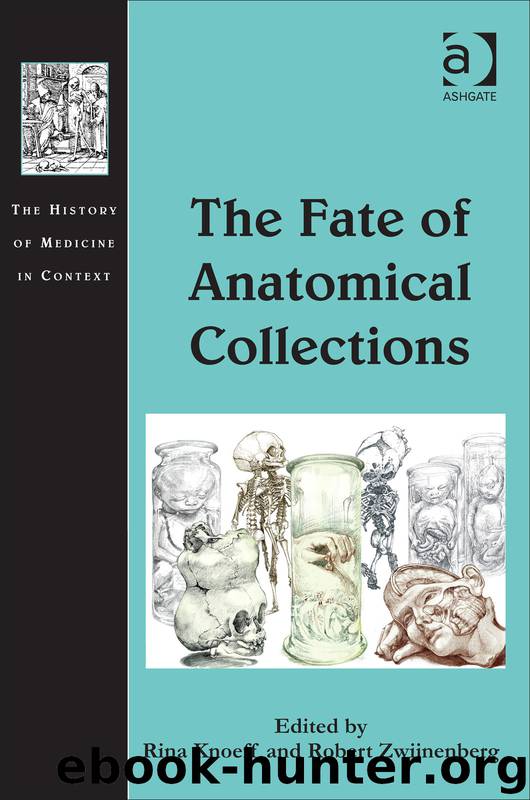The Fate of Anatomical Collections by Zwijnenberg Robert Knoeff Rina & Robert Zwijnenberg

Author:Zwijnenberg, Robert,Knoeff, Rina & Robert Zwijnenberg
Language: eng
Format: epub
Publisher: Ashgate Publishing Ltd.
Published: 2015-12-26T16:00:00+00:00
Conclusions
While anatomy in Vienna very much followed international disciplinary trends – indeed, it sometimes led the way – it was also deeply embedded in Austrian and Viennese society, politics and culture. For this reason, when tracing the fate of anatomical collections, it pays to study them in relation to political, social and urban history. Hyrtl’s exquisite specimens may be seen as a direct extension of a Baroque medical tradition established in the eighteenth century under Maria Theresa and Joseph II, and shaped by their advisor Gerhard Van Swieten, himself deeply influenced by the Dutch anatomical tradition. For Hyrtl and his supporters specimens were educational and research tools, but first and foremost they were objects of beauty – their commercial as well as their scientific value depending on exquisite craftsmanship and elegance just as much as on accuracy and usefulness. His specimens could thus be seen as belonging to the tail end of a period extending from the Renaissance to the nineteenth century when anatomical illustration and anatomical specimens were as much about aesthetics and theology as they were about objective representation of the body and the instruction of medical students.55 In Vienna, the watershed for anatomical collections was 1848 – the year that changed the shape of the city. As anatomy moved away from the church, court and aristocracy, and closer to the General Hospital where clinicians practised ‘modern’ medicine based strictly on observation and experiment, as the university underwent reform and Vienna transformed, allowing the newly emerging and rapidly growing middle and working classes into the city, so the uses and reception of anatomical collections changed. Comparative anatomical collections, once accessible only to university students and faculty members, were not only viewed but also handled by the public who, in Carl Bernhard Brühl’s courses, received radical knowledge of materialism and evolution alongside anatomical instruction. Hyrtl’s exquisite corrosion specimens were always meant to invite the admiration of a wider public, yet by the 1870s this focus on beauty over utility marred their reception, especially among younger anatomists. Producing expensive unique specimens was once a hallmark of a successful anatomist, but now it belonged in the sphere of socially dubious popular museums such as Präuscher’s Prater institution.56 As the city changed, so did the audiences and locations of its anatomical collections, and the ways they were understood and used.
1 J. Szilvássy, ‘Ein öffentlich zugängliches Pathologisch-Anatomisches Museum: Was erwartet der Besucher vom Pathologisch-Anatomischen Bundesmuseum im “Narrenturm” in Wien?’, in Körper ohne Leben: Begegnung und Umgang mit Toten, ed. Norbert Stefenelli, Vienna: Böhlau, 1998, pp. 389–92; Manfred Skopec and Helmut Gröger, Anatomie als Kunst: Anatomische Wachsmodelle des 18. Jahrhunderts im Josephinum in Wien, Vienna: Christian Brandstätter, 2002.
2 T.C.W. Blanning, Joseph II and Enlightened Despotism, London: Longman, 1970, p. 68; Sonia Horn, ‘Eine Akademie in Absicht der Erweiterung der medizinisch-chirurgischen Wissenschaft’ Hintergründe für die Entstehung der medizinisch-chirurgischen Akademie “Josephinum”’, in Josephinismus-eine Bilanz: Échecs et Réussites du Joséphisme, ed. Wolfgang Schmale, Renate Zedinger and Jean Mondot, Bochum: Winkler, 2008, pp. 215–44.
3 Anna Maerker, ‘Florentine Anatomical
Download
This site does not store any files on its server. We only index and link to content provided by other sites. Please contact the content providers to delete copyright contents if any and email us, we'll remove relevant links or contents immediately.
Cecilia; Or, Memoirs of an Heiress — Volume 1 by Fanny Burney(32434)
Cecilia; Or, Memoirs of an Heiress — Volume 2 by Fanny Burney(31868)
Cecilia; Or, Memoirs of an Heiress — Volume 3 by Fanny Burney(31852)
The Great Music City by Andrea Baker(31327)
We're Going to Need More Wine by Gabrielle Union(18967)
All the Missing Girls by Megan Miranda(15562)
Pimp by Iceberg Slim(14379)
Bombshells: Glamour Girls of a Lifetime by Sullivan Steve(13972)
Talking to Strangers by Malcolm Gladwell(13222)
Norse Mythology by Gaiman Neil(13204)
Fifty Shades Freed by E L James(13157)
For the Love of Europe by Rick Steves(12927)
Mindhunter: Inside the FBI's Elite Serial Crime Unit by John E. Douglas & Mark Olshaker(9186)
Crazy Rich Asians by Kevin Kwan(9167)
The Lost Art of Listening by Michael P. Nichols(7403)
Enlightenment Now: The Case for Reason, Science, Humanism, and Progress by Steven Pinker(7228)
The Four Agreements by Don Miguel Ruiz(6622)
Bad Blood by John Carreyrou(6543)
Weapons of Math Destruction by Cathy O'Neil(6142)
